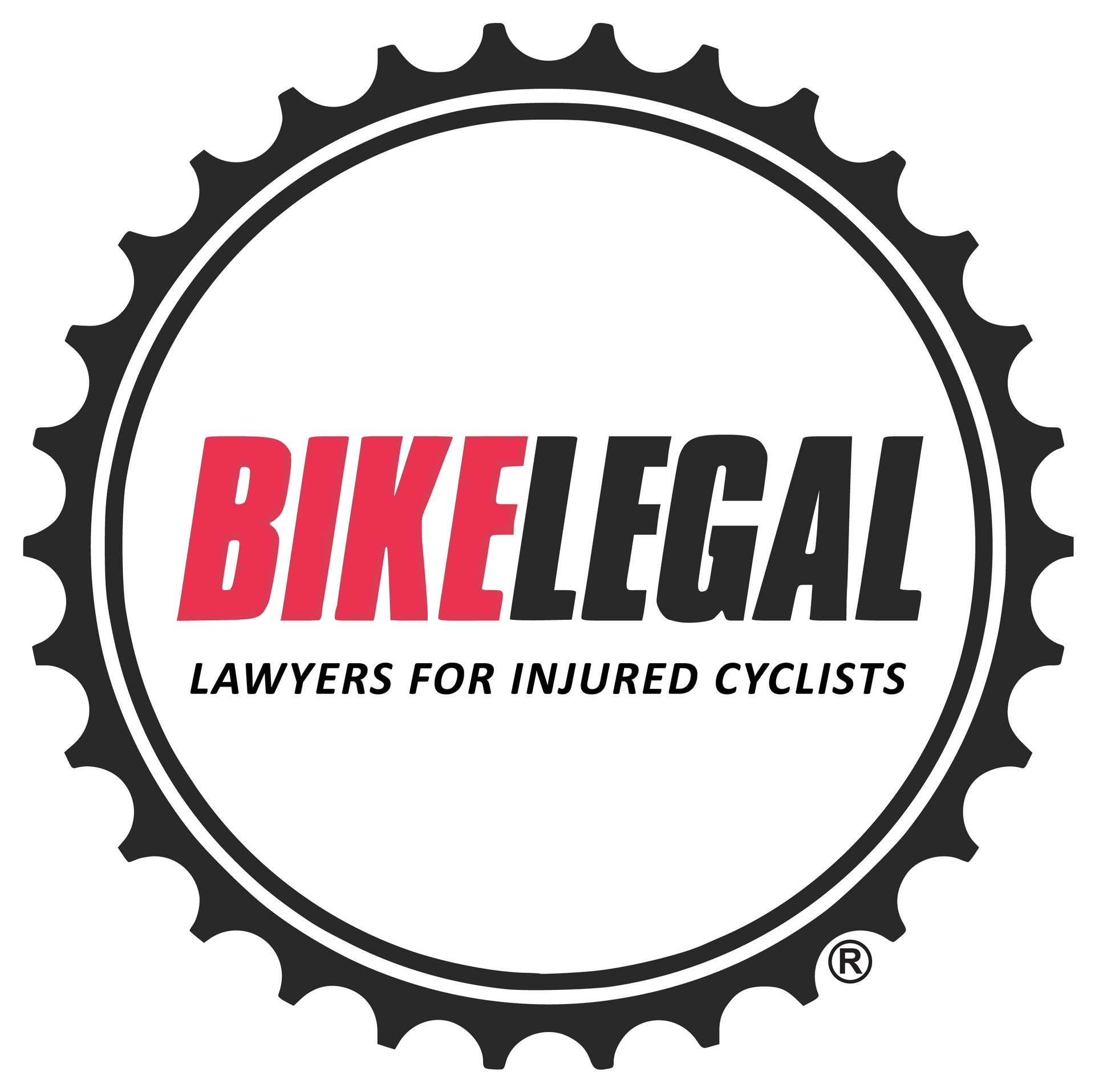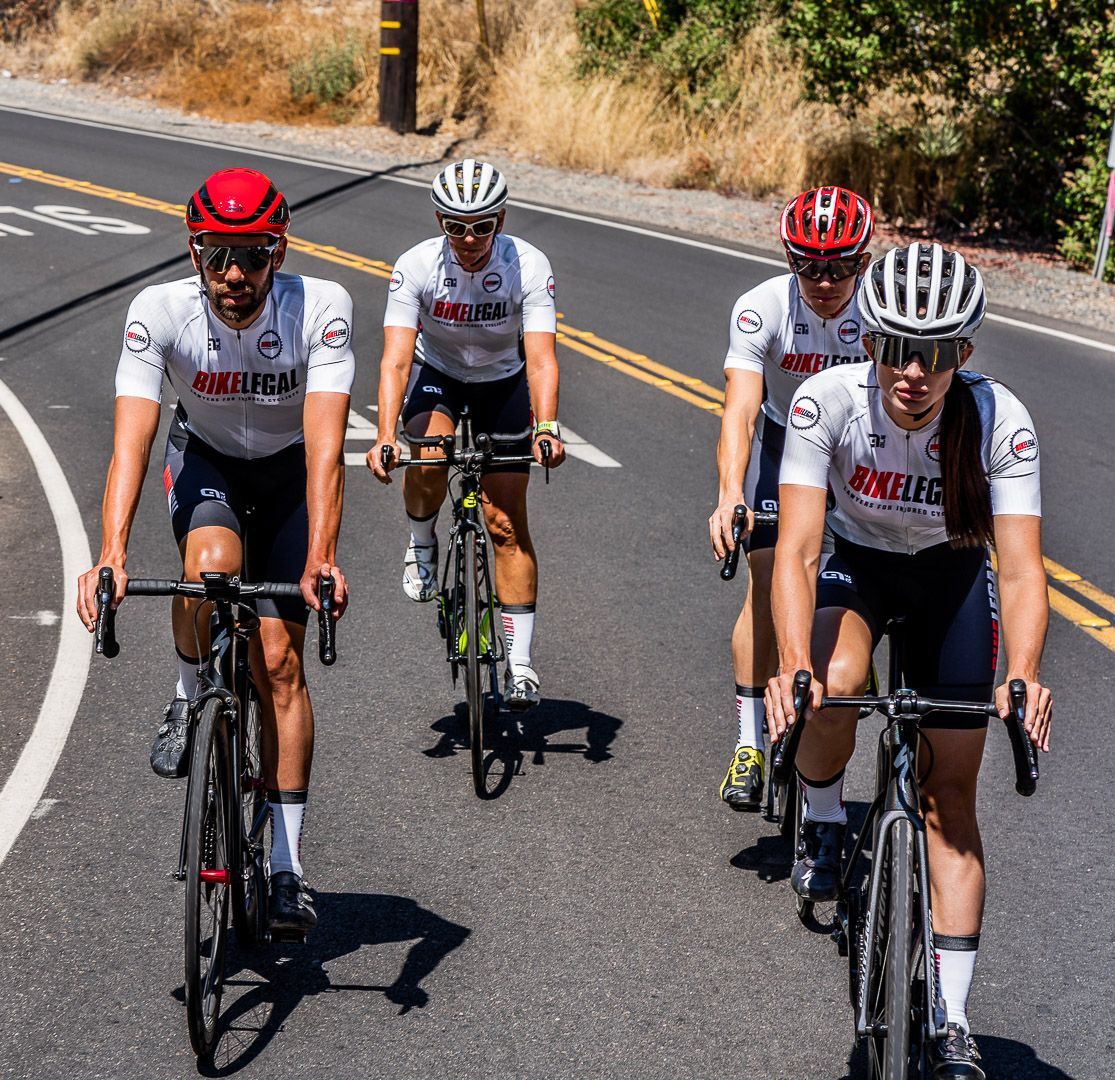Arizona Bicycle Accidents: Statistics, Laws, & Tips
Follow us on
social media!
Cycling in Arizona requires understanding essential bicycle laws that protect cyclists, from helmet requirements and safe passing distances to clear guidelines on road-sharing responsibilities.
This guide breaks down Arizona’s bicycle safety rating, bicycle accident statistics, e-bike classifications, and top bike-friendly cities, offering practical tips and legal insights to help you ride safely and responsibly.
This guide covers the following:
- Pros of Cycling in Arizona: The state's scenic beauty, ideal cycling weather, and vibrant cycling communities.
- Challenges for Cyclists in Arizona: Navigating urban traffic, varied terrain, and areas with limited cycling infrastructure.
- Bicycle Accident Statistics: A look at recent cycling accident trends and their implications for safety in Arizona.
- State-Specific Bicycle Laws: Key cycling laws in Arizona, including safe passing rules and helmet regulations.
- Arizona Electric Bicycle (E-bikes) Classifications and Rules
- Cycling Safety Rankings: Arizona's standing in national cycling safety rankings and performance in key safety categories.
- Safe Cities for Cyclists: Identifying cities in Arizona that excel in cyclist safety.
- UM/UIM Coverage Importance: The necessity of Uninsured/Underinsured Motorist coverage for cyclists in Arizona.
- Cycling Advocacy Efforts: The role of state and major city advocacy groups in promoting cycling safety and infrastructure.
- Post-Accident Steps for Cyclists: Essential actions to take after a cycling accident in Arizona.
- Role of Bicycle Accident Attorneys: The importance of specialized legal representation in cycling accident cases.
Benefits of Cycling in Arizona's Diverse Landscapes
Arizona's unique landscape is a paradise for cyclists, from its breathtaking scenic routes to its vibrant cycling communities. Here's why you should consider cycling in the Grand Canyon State:
- Scenic Beauty: Arizona's diverse landscapes, including the iconic Grand Canyon, the red rocks of Sedona, and the lush Sonoran Desert, offer an ever-changing backdrop for your rides.
- Year-Round Cycling Weather: With over 300 days of sunshine a year, Arizona is a cyclist's dream. The weather allows for year-round riding, a rarity in many states.
- Cycling-Friendly Cities: Cities like Tucson and Phoenix are investing in cycling infrastructure, making urban cycling safer and more enjoyable.
- Thriving Cycling Community: Arizona's cycling community is welcoming and diverse, offering a range of clubs and events for riders of all levels.
- Health Benefits: Cycling in Arizona is not just a feast for the eyes but also a boost for your health, offering cardiovascular, muscle-building, and mental health benefits.
Challenges Arizona Cyclists Face: Traffic, Terrain, and Infrastructure
Cycling in Arizona is undeniably rewarding, but like any adventure, it comes with its own set of challenges. Acknowledging these helps in preparing for a safer and more enjoyable ride.
- Traffic in Urban Areas: Despite improvements, cities like Phoenix and Tucson have bustling traffic. Navigating these urban settings demands extra vigilance and skills from cyclists.
- Varied Road Conditions: Arizona's terrain varies greatly, offering everything from smooth city paths to rugged rural trails. Adapting to these changing conditions is essential for a safe cycling experience.
- Limited Bicycle Infrastructure in Some Regions: While urban centers are becoming more bike-friendly, many areas in Arizona still lack comprehensive cycling infrastructure, necessitating sharing the road with vehicles.
Arizona Bicycle Accident Statistics: Recent Trends & Safety Insights
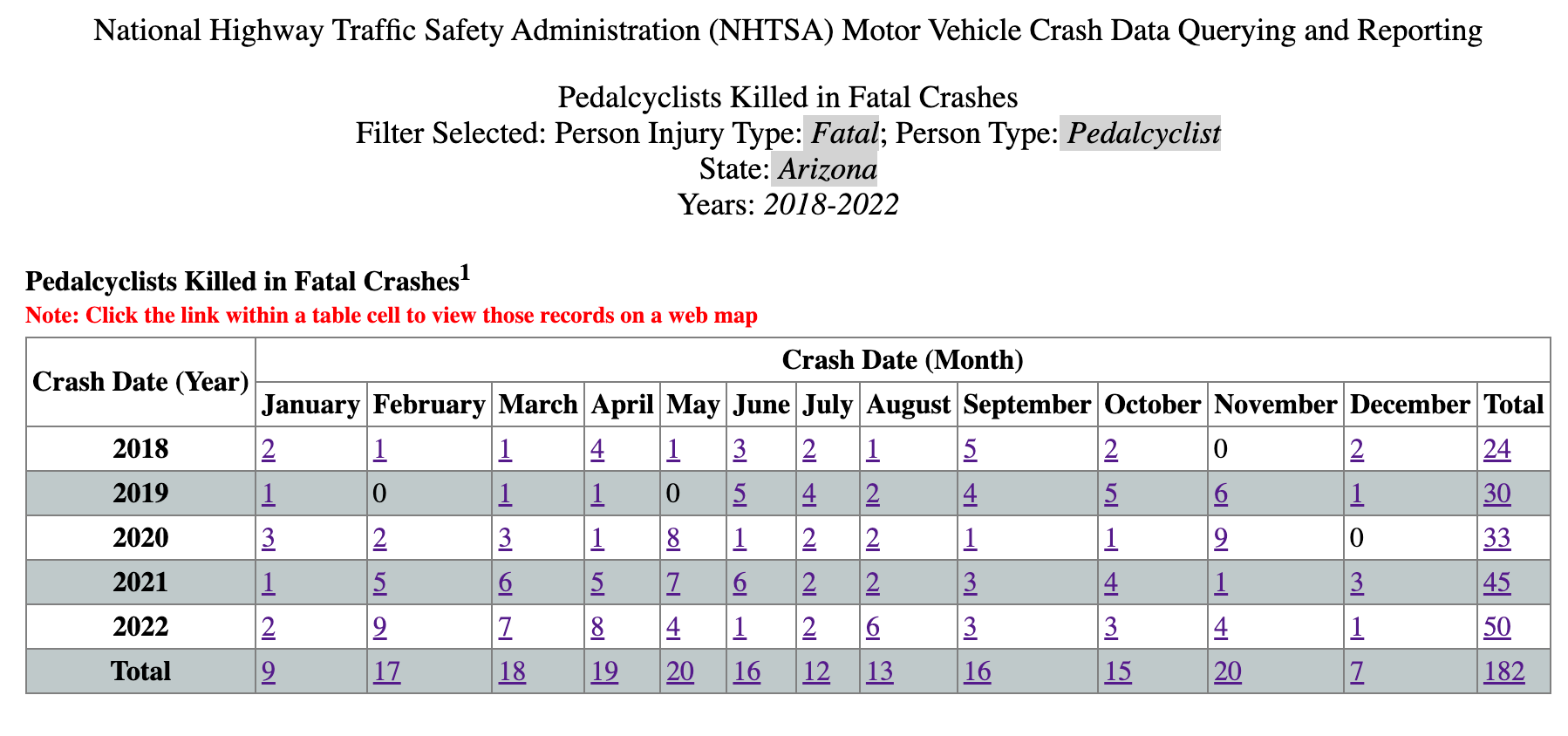
Arizona’s bicycle accident statistics reveal a concerning trend of increasing fatalities over recent years. Despite efforts to improve cycling infrastructure and awareness, fatal accidents have steadily risen, with 24 bicycle-related deaths in 2018, climbing to 50 by 2022.
This upward trend underscores the urgent need for cyclists and drivers alike to understand and follow safety laws designed to protect everyone on the road.
- In 2022, Arizona reported 1,159 bicycle accidents. Of these, 48 were fatal, and 1,128 cyclists suffered injuries.
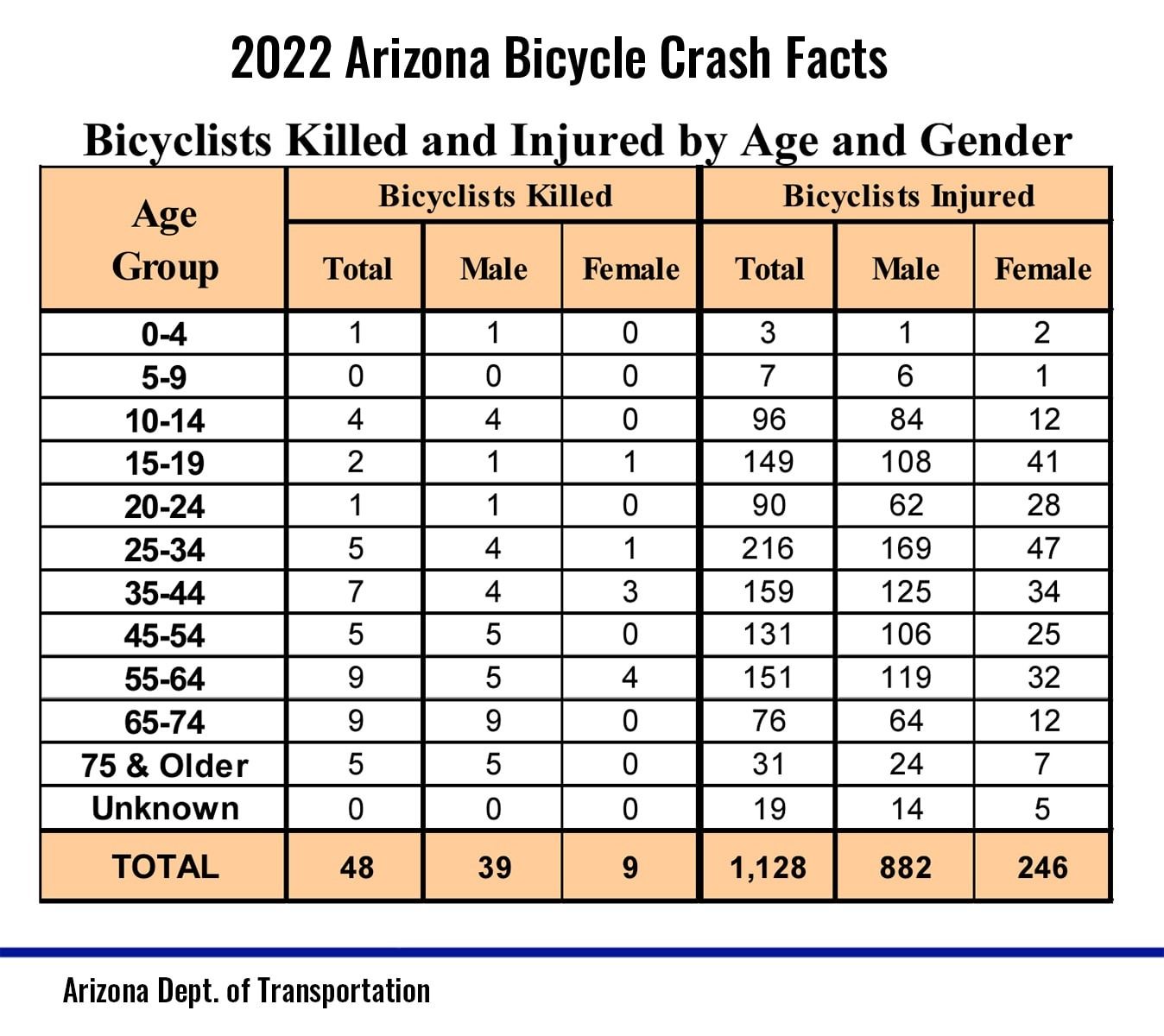
- Maricopa and Pima Counties alone accounted for 83.35% of these crashes. Compared to pedestrian accidents, where 16.05% were fatal, bicycle crashes had a 4.06% fatality rate.
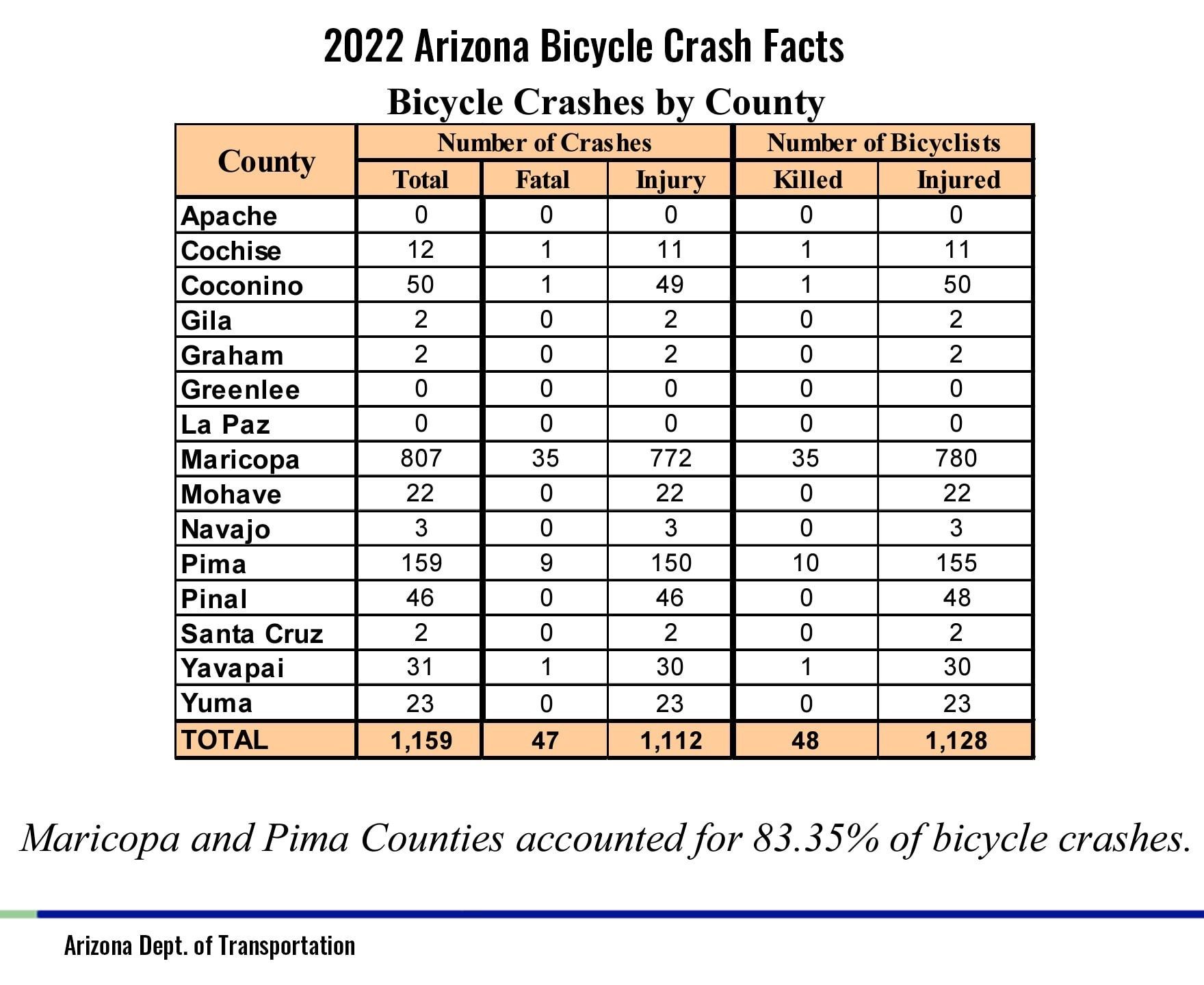
- Comparatively, bicycle crashes had a lower fatality rate (4.06%) than pedestrian accidents (16.05% fatal).
- The 2021 Crash Facts Report reveals that the majority of bicycle crashes occurred during the daytime, with a smaller fraction (22%) happening at night. Yet, nighttime crashes carried a heavier toll in terms of severity; 40% of these after-dark accidents were fatal, almost doubling the likelihood of fatalities compared to daytime crashes.
- An alarming insight from 2020 data shows that nearly eight out of ten collisions not occurring at intersections happened on arterial streets, highlighting a significant risk in these areas.
Arizona Bicycle Laws: What Motorists and Cyclists Need to Know
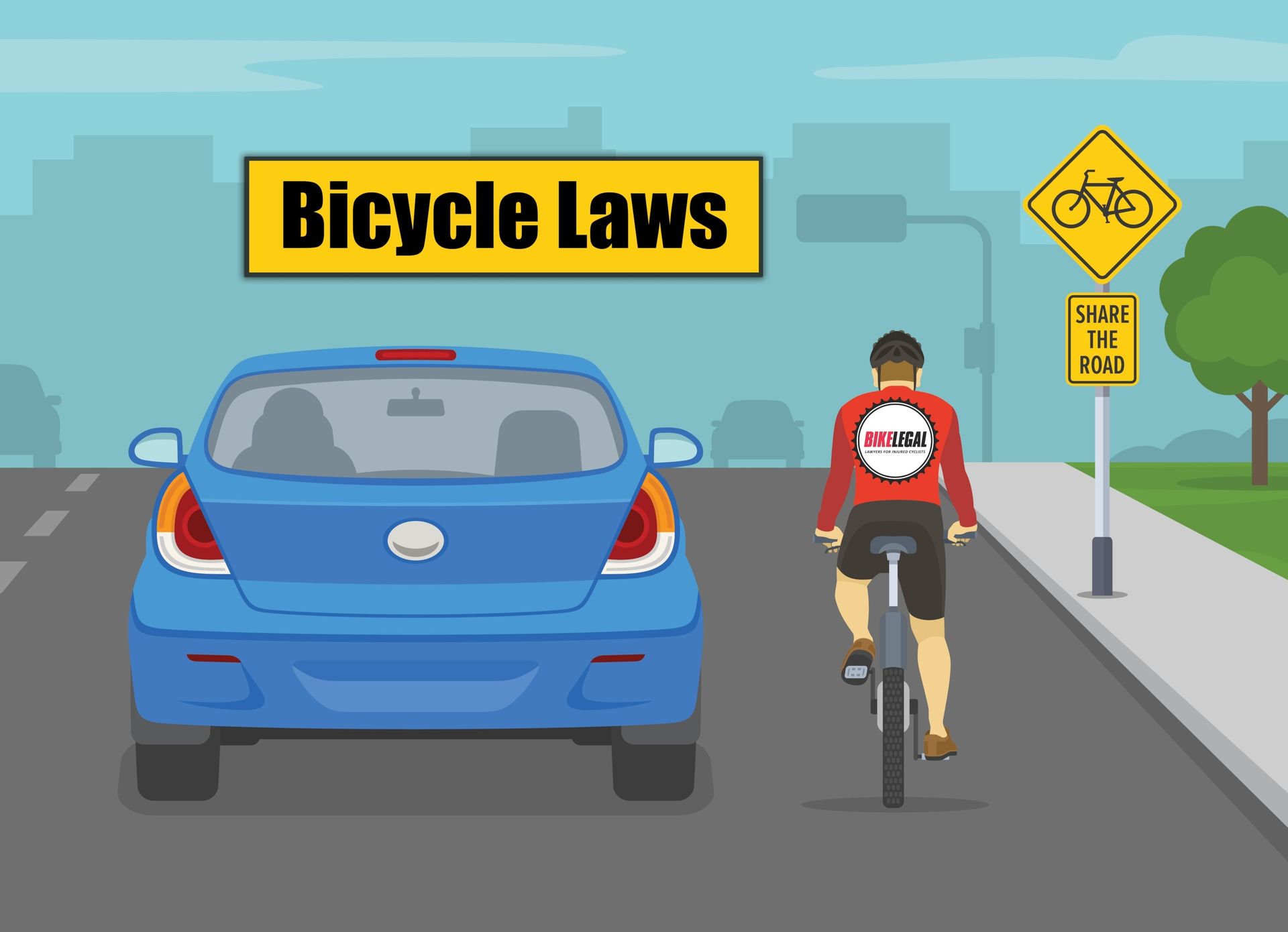
In Arizona, bicycles are recognized as vehicles, meaning cyclists have the same rules, rights, and responsibilities as other road users. This includes adhering to traffic laws in school zones, yielding to other vehicles in roundabouts, and following standard road signals. Arizona's bicycle laws are designed to protect cyclists and facilitate safe, respectful interactions between all road users.
You must follow safe cycling practices and ensure you are compliant with the following laws:
Arizona Bicycle Laws For Motorists
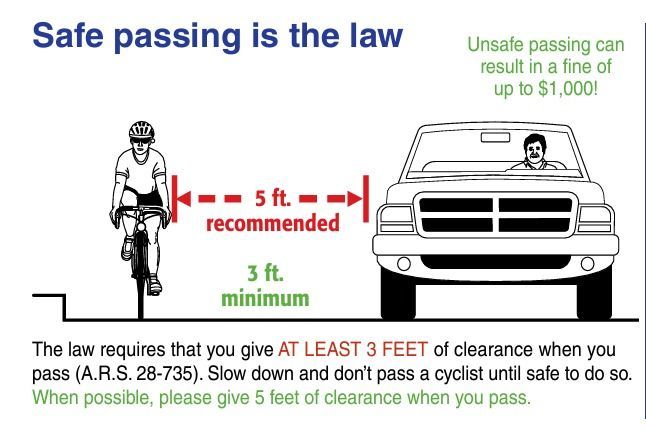
- Safe Passing Law: Motorists must provide a minimum of 3 feet of clearance when passing a cyclist, with 5 feet preferred where possible. This rule helps prevent close encounters that could lead to accidents, particularly on roads with narrow lanes.
- Harassment of Cyclists: Harassing or intimidating cyclists is strictly prohibited. This includes tailgating, yelling, or obstructing a cyclist’s path. Such behavior endangers cyclists and can lead to penalties for the motorist.
- Crossing the Centerline to Pass: If necessary to maintain a safe passing distance, motorists are allowed to cross the centerline when overtaking a cyclist, provided it is safe to do so.
- Bike Lane Use and Right Turns: Motorists should never enter a bike lane except when turning, entering, or leaving the roadway, or parking where allowed. Always yield to cyclists when crossing a bike lane, and check blind spots and mirrors, especially before right turns, to avoid cutting off cyclists.
- The Door Zone: Opening a car door into a bike lane or road without checking for cyclists can lead to serious accidents. Arizona law requires motorists to ensure no cyclists are approaching before opening doors.
- Using Turn Signals: When turning or changing lanes, motorists must signal their intentions at least 100 feet in advance, giving cyclists and other drivers time to react.
Arizona Laws For Bicyclists
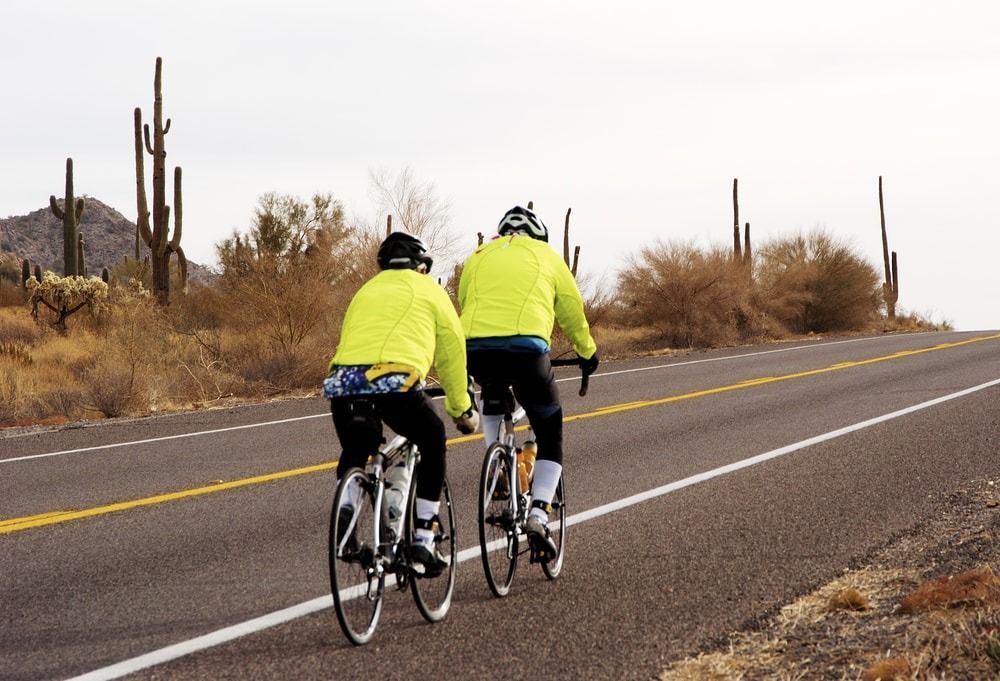
- Bicycles as Vehicles: Arizona law classifies bicycles as vehicles, subjecting cyclists to the same rights and responsibilities as motor vehicle operators. Cyclists must follow all traffic laws, including those in school zones, where they must reduce speed and refrain from passing other vehicles.
- Direction of Travel: Cyclists must travel in the same direction as other traffic. Riding against traffic is both illegal and dangerous, increasing collision risk.
- Lane Position: Cyclists traveling slower than traffic should keep as close to the right-hand curb or edge of the roadway as practical. Exceptions include preparing for a left turn, passing, avoiding hazards, or if the lane is too narrow for safe side-by-side travel with vehicles.
- Riding Two Abreast: Cyclists may ride two abreast in a single lane. However, when doing so on roads without a designated bike lane, riders should yield to allow traffic to pass safely.
- Bike Paths and Multi-Use Paths: On bike paths or multi-use paths designated by local authorities, cyclists should use caution and yield when necessary. Vehicles are not permitted to park or stand on bike paths unless required by emergency circumstances.
- Turning and Signaling: Cyclists must signal turns and lane changes, using hand signals to show intent. Signals must be given at least 100 feet before turning:
- Left turn: Left arm extended straight out.
- Right turn: Left arm bent up at the elbow or right arm extended straight out.
- Stopping: Left arm bent downward at the elbow.
- Yielding to Traffic in Roundabouts: In roundabouts, cyclists must yield to traffic already in the roundabout, including other cyclists, before entering. Alternatively, they can dismount and walk their bikes as pedestrians.
- Red Light and Stop Sign Compliance: Cyclists must obey all red lights and stop signs. Arizona does not have an “Idaho Stop” law, so cyclists are required to come to a complete stop at stop signs.
- Sidewalk Riding: Cyclists are allowed to ride on sidewalks unless otherwise restricted by local ordinances. However, they must yield to pedestrians and provide an audible signal when passing.
- Arizona Bicycle Helmet Law: While Arizona does not have a statewide helmet law, many cities and counties require helmets for riders under 18. Helmets are encouraged for all cyclists, as they significantly reduce the risk of head injury in an accident.
- Visibility and Lighting Requirements: Arizona State law requires cyclists riding at night to use a white front headlight and at minimum a red rear reflector, both of which enhance visibility and reduce the risk of accidents. Reflective or bright clothing is also recommended to increase visibility.
- Brakes and Hand Control: All bicycles must have a brake that allows the wheels to skid on dry pavement, providing reliable stopping power. Cyclists must keep at least one hand on the handlebars at all times for safe control.
- Passenger Limitations: Bicycles should not carry more passengers than they are designed for. Riders are prohibited from carrying others on handlebars or other parts not intended for seating.
Electric Bicycles (E-Bikes) in Arizona
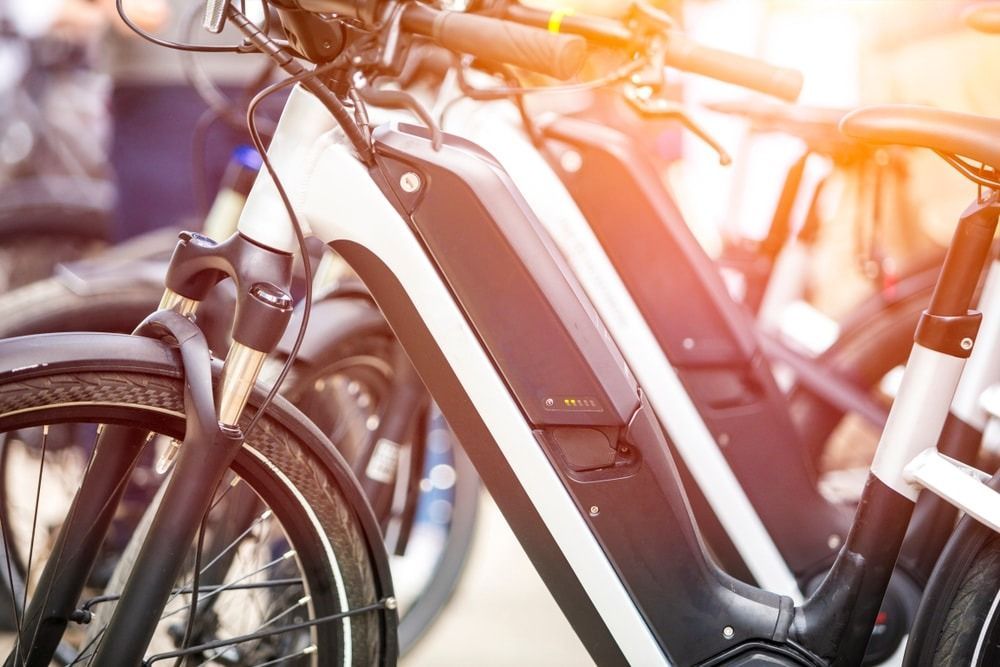
Rights and Responsibilities: Electric bicycles (e-bikes) in Arizona are subject to the same rules and privileges as standard bicycles, with some exceptions specific to e-bikes. They do not require registration, a title, insurance, or a driver’s license, simplifying their regulation compared to motor vehicles.
E-bike Classification and Pathway Use: Arizona classifies e-bikes based on speed and motor assistance:
- Class 1 and Class 2 e-bikes, which assist up to 20 mph, can be used on bicycle and multi-use paths unless a local authority restricts them.
- Class 3 e-bikes, which can assist up to 28 mph, are typically restricted to roadways or paths adjacent to highways unless local authorities allow their use on specific bike paths.
Labeling and Identification: All e-bikes sold in Arizona after 2019 must display a label indicating their class, top assisted speed, and motor wattage. Electric scooters must also have unique, visible identification to help authorities and users distinguish them from other vehicles.
Is Arizona Safe for Bicyclists?
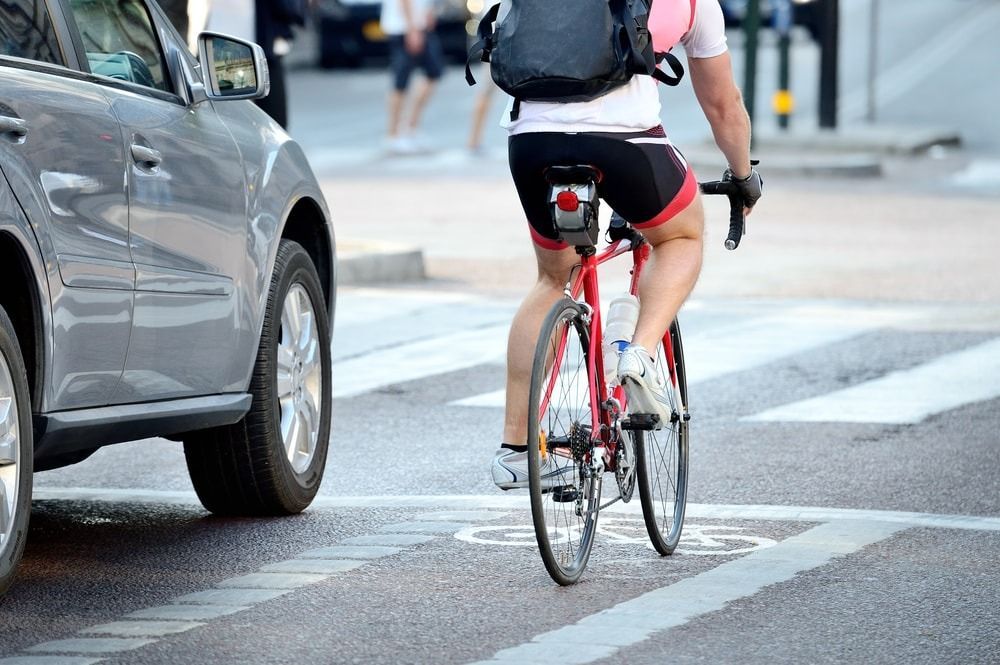
Arizona ranks 31st in the Bicycle Friendly State℠ Ranking by the League of American Bicyclists for 2022 and is listed as the 7th most dangerous state for cyclists. Here’s how Arizona scores in key areas:
- Infrastructure & Funding (C+): This grade shows room for improvement in cycling infrastructure. For example, Arizona has less than 2 miles of bike lanes per 100,000 residents, well below the national average. Enhanced bike paths and safer road designs are needed to uplift this score.
- Education & Encouragement (C+): There's potential for more extensive safety education programs. Implementing initiatives like community cycling workshops or school-based bike safety courses can be game changers.
- Traffic Laws & Practices (B): This relatively high score indicates a sound legal framework for cyclists. However, further refinement, like stricter enforcement of existing laws and promoting cyclist awareness among drivers, could boost cyclist safety.
- Policies & Programs (C): More targeted safety policies and support programs are required. For instance, establishing more 'Bike to Work' days or city-sponsored cycling events can encourage safer cycling practices.
- Evaluation & Planning (D+): A critical area needing attention. There's a need for ongoing assessment of cycling accidents and data-driven strategies to reduce them. Implementing tools like interactive accident maps and regular safety audits can provide insights for improvement.
These grades show that while Arizona has the foundations for a safe cycling environment, significant improvements are necessary to ensure cyclist safety across the state.
Safe Cities Rankings for Cyclists in Arizona
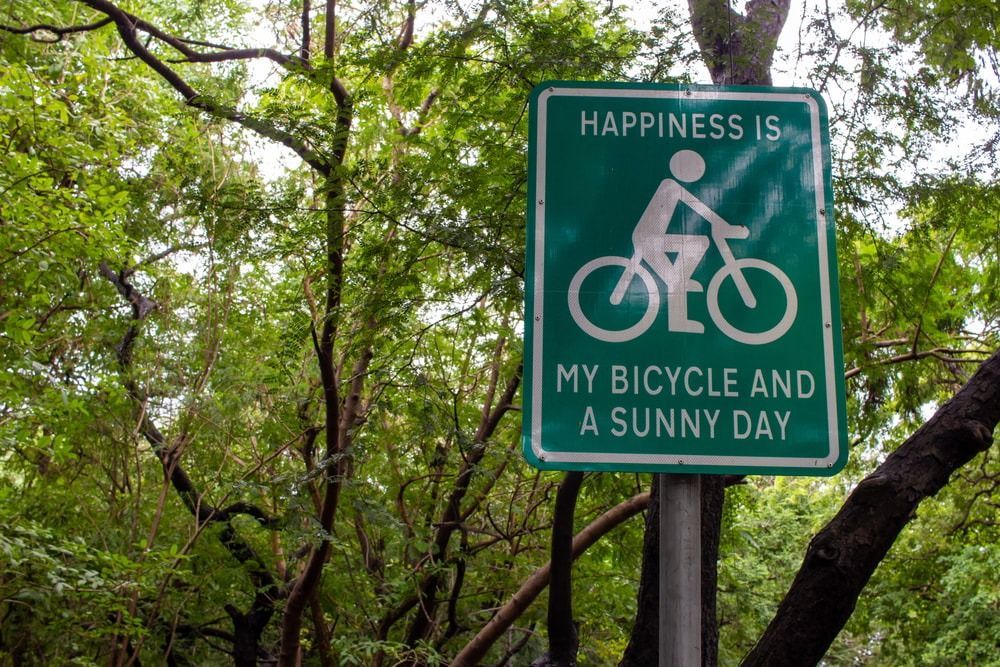
Even with Arizona’s placement on the list of dangerous states for cyclists, some cities stand out for their safety efforts.
- Flagstaff has been taking significant measures to protect cyclists, earning a favorable safety ranking. It reflects what can be achieved with a strong focus on creating a safer cycling environment.
- Tempe is also taking notable steps toward cyclist safety. It has been actively improving bike paths and promoting safety education, making it another city in Arizona that is prioritizing the well-being of its cyclists.
These cities demonstrate that despite statewide challenges, progress is being made at the local level to ensure that cyclists can enjoy a safer riding experience.
The Need for UM/UIM Coverage in Arizona
In Arizona, 11.9% of drivers are uninsured, placing it in the lower percentage category and ranking it 27th among states for uninsured motorists as of 2022.
With the state-mandated minimum liability limits set at 25/50/15—translating to $25,000 for bodily injury per person, $50,000 for bodily injury per accident, and $15,000 for property damage—it’s essential to consider the potential financial implications following an accident with an uninsured or underinsured driver.
Uninsured/Underinsured Motorist (UM/UIM) coverage becomes a critical safeguard in these scenarios. UM/UIM may cover medical expenses, lost wages, and even repair costs that arise from an accident caused by a driver who either lacks insurance or whose insurance is insufficient to cover the damages incurred. This coverage is particularly significant in Arizona, where the chance of encountering an uninsured driver is reasonably high.
For cyclists, this coverage takes on extra importance. In the event of an accident with a motor vehicle, the physical and financial damages can be substantial. UM/UIM coverage provides an added layer of protection that can help cover unforeseen costs, ensuring that cyclists are not left financially vulnerable after an incident.
State Advocacy Groups in Arizona

Several organizations in Arizona are at the forefront of advocating and fostering a safer and more inclusive cycling environment across Arizona.
- The Coalition of Arizona Bicyclists: Promotes safer and increased bicycling in Arizona through education, advocacy, and collaboration with law enforcement and transportation planners.
- Greater Arizona Bicycling Association (GABA): Promotes bicycle education and safety and organizes community events.
- Arizona Bicycle Club (ABC): One of the oldest clubs in the state, dedicated to advancing the interests of cyclists through rides, education, and community outreach.
In addition to these efforts, Bike Legal- Arizona bicycle accident attorney ensures cyclists' rights are protected, providing resources and support in the wake of cycling-related incidents. Engaging with these organizations can be an important step for any cyclist seeking to contribute to the broader conversation on cycling safety and legislation in Arizona.
Major Cities Advocacy Groups in Arizona
In Arizona's vibrant urban centers, dedicated advocacy groups are the heart of the cycling community's push for better policies, infrastructure, and safety. These include:
- Phoenix Metro Bicycle Club (PMBC): A vital voice in the Phoenix area, PMBC encourages safe cycling with a strong community presence and advocacy for improved cycling conditions.
- Tucson-Pima County Bicycle Advisory Committee: This committee works closely with local governments in the Tucson area to advise on bicycle-related matters and foster a safer biking environment.
- Flagstaff Biking Organization: Engaged in advocating for trails and bike education, this group is a significant player in promoting cycling in Northern Arizona.
- Bike Saviours Bicycle Collective: A Tempe-based group that not only advocates for cyclists' rights but also provides education on bicycle repair and maintenance.
These city-centric groups are integral in driving progress for cyclists' rights and safety, offering education, community support, and a platform for advocacy. Their tireless work ensures that cycling in Arizona's major cities is not just a mode of transportation but also a celebrated part of the local culture.
What to Do If You've Been Involved in a Cycling Accident in Arizona?
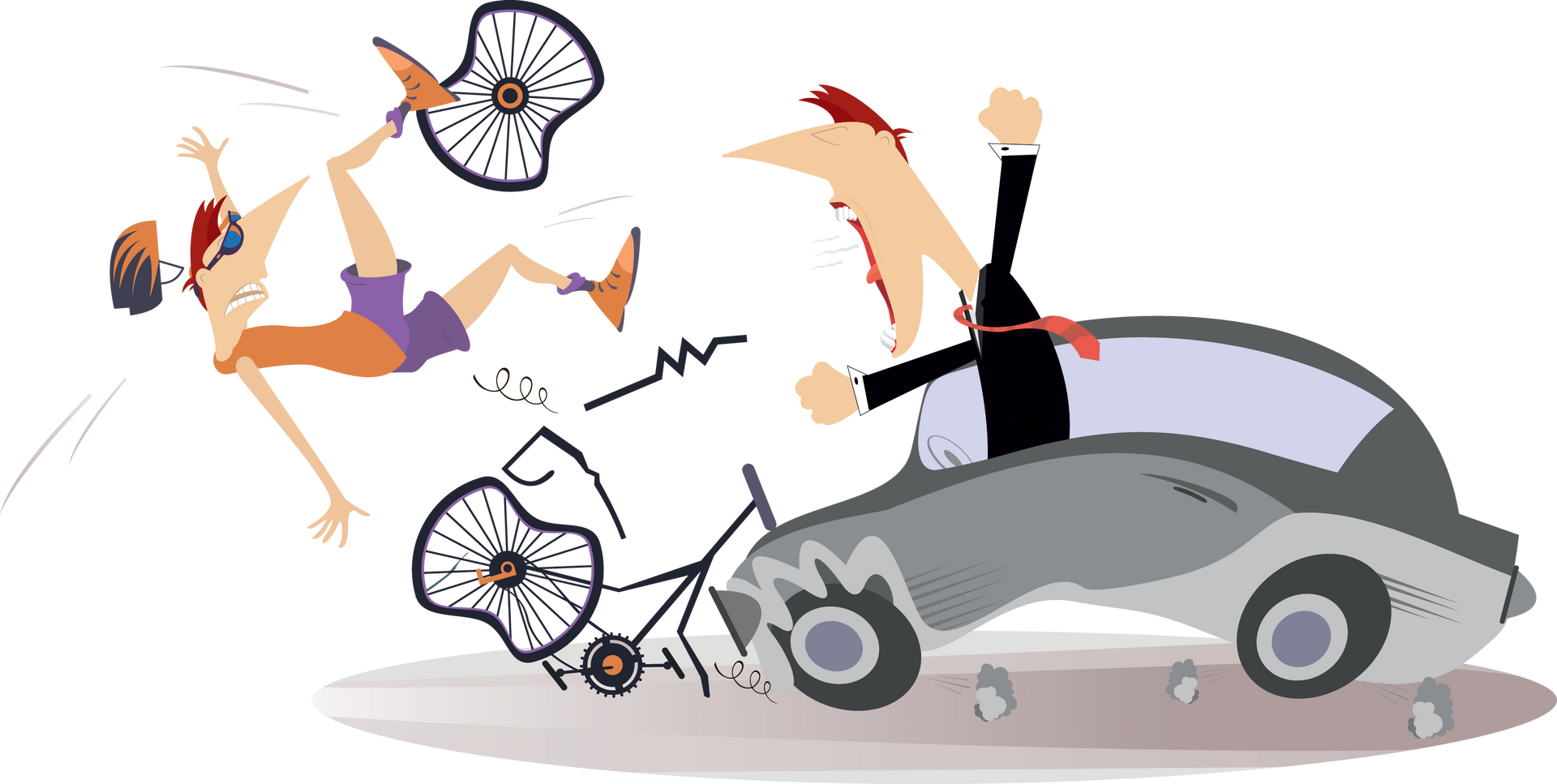
If you're involved in a cycling accident in Arizona, taking the right actions promptly can significantly affect the outcome:
- Ensure Safety and Call for Help: Prioritize your well-being. Call 9-1-1 if injured and move to a safe location off the road to prevent further hazards.
- Document the Accident and Exchange Information: Obtain the other party's contact, insurance details, and vehicle information. Document the scene with photos, gather witness contact details, and keep a record of your medical treatment and expenses.
- Wait for Police to Arrive: Stay at the scene until authorities arrive. A police report is vital, especially for incidents involving substantial damage or injuries.
- Avoid Admissions or Negotiations: Limit interactions with the other party to necessary information exchange. Refrain from discussing fault or making agreements about the accident.
- Seek Medical Attention and Legal Advice: Even if injuries seem minor, get medical attention promptly. Contact your insurance to report the accident and consider consulting a bike injury lawyer for guidance through Arizona's legal procedures.
Why You Need an Arizona Bicycle Accident Attorney?
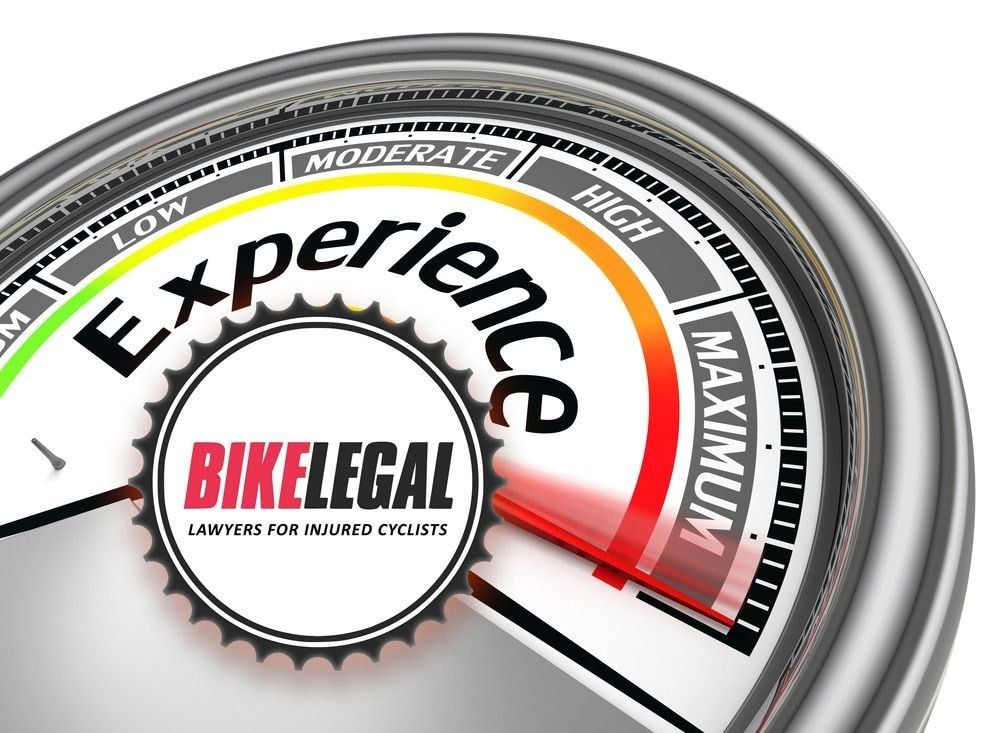
Having an experienced attorney from a reputable bicycle accident law firm is crucial in effectively navigating the complexities of cycling accidents. Here are key reasons why their expertise is essential:
- Comprehensive Understanding of Cycling Laws: A bicycle crash lawyer brings a deep knowledge of Arizona's cycling laws, crucial for interpreting the specifics of bicycle accidents and advocating for cyclists' rights effectively.
- Experience with Insurance Companies: Familiarity with how insurance companies operate equips a cycling attorney with the skills to navigate complex claims processes, ensuring your rights are comprehensively protected.
- Expertise in Settlement Negotiations: A bike injury lawyer also excels in negotiating settlements. They work to secure fair compensation, which is vital for achieving the best outcomes in court and settlement discussions.
- Assessing Overall Impact: An experienced bicycle accident attorney understands the deeper consequences of injuries, including lost wages and life impacts. They ensure settlements address all future needs resulting from the accident.
For those involved in cycling accidents, securing the right legal representation is key. Bike Legal is equipped to connect you with the best bicycle accident attorney in Arizona. Their specialized knowledge is precisely what's needed in these situations.
Key takeaways
- Make the most of Arizona's scenic routes, favorable weather, and strong cycling community.
- Be prepared for urban traffic, changing road conditions, and areas with limited cycling infrastructure.
- Understand the bicycle accident statistics to comprehend the safety landscape in Arizona.
- Recognize where Arizona stands in terms of cycling safety and what improvements are needed.
- Note which Arizona cities offer better safety for cyclists, and their specific initiatives.
- Understand the importance of Uninsured/Underinsured Motorist coverage as a cyclist in Arizona.
- Familiarize yourself with Arizona's specific cycling laws for safe and lawful riding.
- Connect with local cycling advocacy groups for support, updates, and community engagement.
- Learn the immediate steps to follow if involved in a cycling accident in Arizona.
- Recognize the importance of having a specialized bicycle accident attorney for legal guidance and support.
Request a free consultation by calling 877-BIKE LEGAL (877 245-3534) or submitting a form.
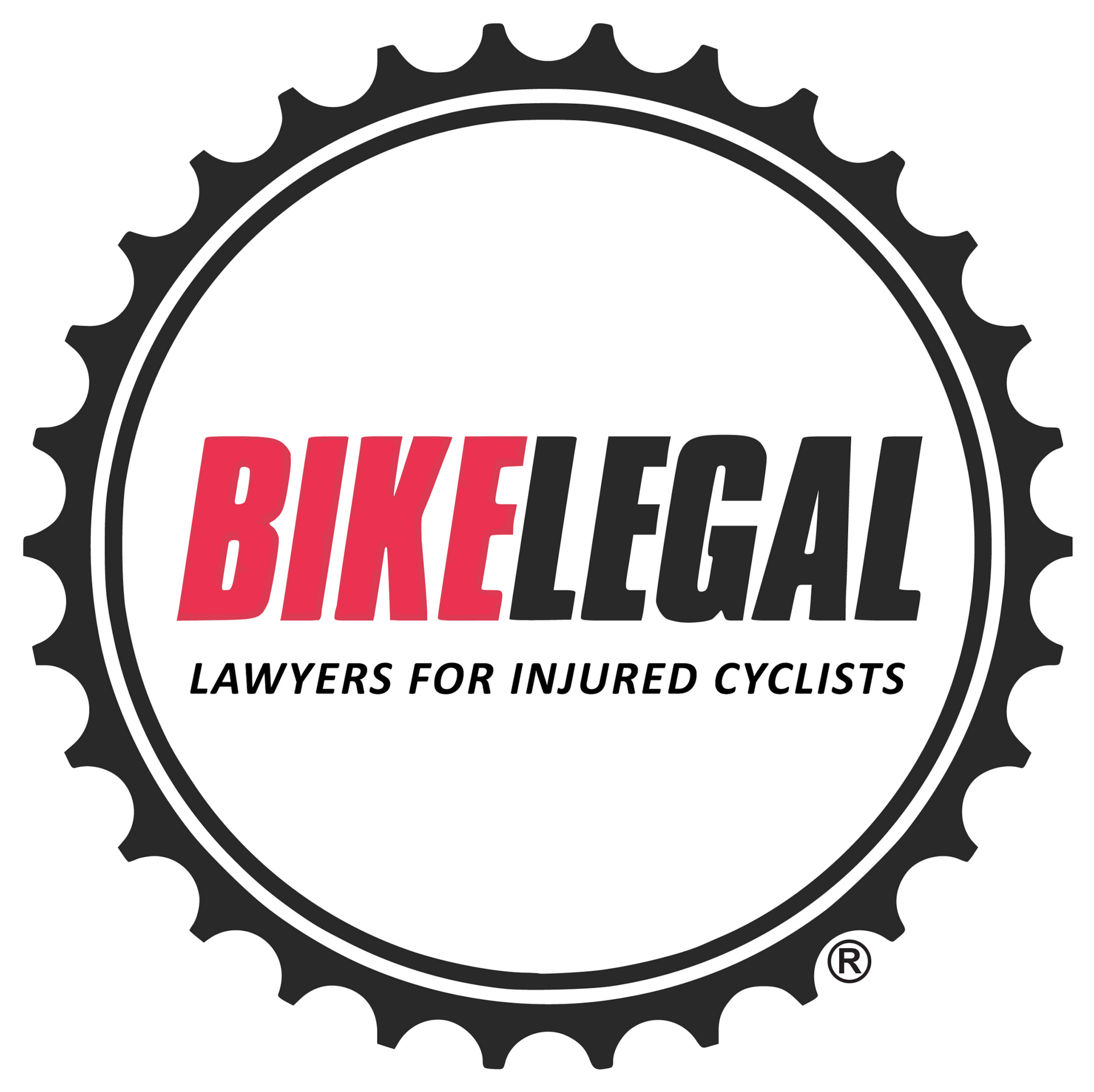
Read Next
- Three Feet Law
- Answers to the 10 Most Asked Bicycle Accident FAQ's
- The Most Common Dangers of Cycling on the Road
- Can You Ride a Bike on the Sidewalk?
- Do Cyclists Have to Stop at Stop Signs?
- Cycling Under the Influence: Marijuana DUI and Bicycle Accidents
- The Bicycle Lane Debate: Should Motorists Share the Road?
